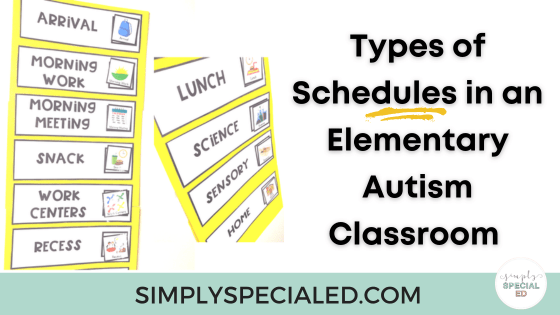

Teaching in a self-contained special education classroom, I work in a very structured environment. Each part of our day is planned to make sure our classroom chaos is kept to a minimum. The students I work with thrive on clear expectations. I use a variety of schedules in my classroom to provide consistency and routine.
*At the time of writing this, my school is under construction and I do not have access to my personal materials so all examples and pictures are from other Simply Special Ed contributors.
Visual Daily Schedules


Whole Group Schedule: A consistent daily schedule is the key to success in any classroom, but especially so in the special education setting. I use a visual schedule at the front of my classroom to display our daily routine. As we finish an activity, I will have a student turn over that card in order to keep track of where we are in the day. Although we try to maintain consistency, we all know that things come up and days don’t always go as planned! I keep a magnetic pointer near my schedule to point out any “oops” or changes to our schedule. This is a great visual to help students prepare for any number of changes like indoor recess or a school assembly.
Student Schedule: In addition to our whole group schedule, I create a similar visual schedule for each student. This allows my to include activities specific to that student such as a visit from their favorite speech pathologist, inclusion with their gen. ed peers, or if they are leaving early for their ABA therapy. Below their personal schedule is a bucket to collect the cards of the completed tasks throughout the day.
Head over to this blog to see how to use a schedule in a middle/high school setting!
Slide Schedules


Throughout the day, I use slides that go through our daily routines all the way from arrival to dismissal. When we move between activities or areas of the school, a visual will pop up to prepare my students for the transition. Typically, I give my students a 10, 5, and 1 minute reminder prior to the transition. These slides help prevent frustration and anxiety students might experience if they aren’t wanting to leave a preferred task or don’t know what to expect next.
Task Schedules


There are times throughout the day where a simplified schedule is more beneficial than a layout of the day. Visuals like the first-then and 1-2-3 boards can support students as they complete activities during a work station or non-preferred activity. These can be kept on binder rings or folders for easy access and portability to different areas across the school! These travel well with my students who receive inclusion time in a general education classroom. This way both the gen. ed teacher and myself are consistent with our expectations and routines.
Master Schedule


Creating a master schedule for a self-contained classroom is an art! It’s a lot to manage multiple students all with varying schedules as well as planning for para responsibilities. It’s important to have this printed and hung up in your classroom, however, I encourage you to save your color ink and lamination pouches the first few weeks of school, because you know that schedule will be changing! When drafting your schedule, begin with the parts of your day that will not change such as breakfast, lunch, and specials (PE/music/art). This will help create an outline where you can fill in your instructional minutes and service times. Please don’t neglect yourself! Make sure to include a full lunch time and planning period for you as well.
Schedule SOS
Schedules in your classroom will help promote predictability, reduce student anxiety, and improve transitions between activities and classrooms. Whether you are a first-year teacher or a veteran, I encourage you to check out the course: Simple Self-Contained Setup 101. In module 1, you will learn all about the 4 most important elements to your daily schedule and how to build it from scratch!





